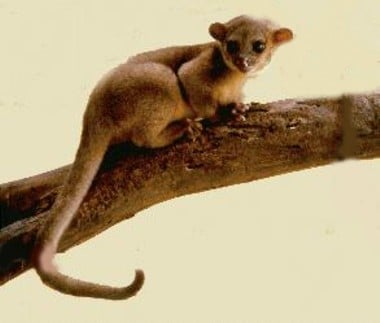Ten Mammals You Have Never Heard Of, Part 1
Blueprint Earth science writer Stewart Mittnacht explores the adaptability and tenacity of mammals. Their existence demonstrates that even as habitats change, there is hope that life will find answers to whatever the future may hold.
Mammal diversity is truly extraordinary. Our success is derived from a multitude of features unique to the mammalian body. Some of these features are obvious, such as our ability to produce milk (the word “mammal” refers to the mammary glands), the presence of insulating hair, and the middle ear bones.
Other unique features of mammals are more obscure, but they play a major role in mammal diversity, such as the neocortex of the brain (the “frontal lobe” and its supporting hardware), which has given us a heightened sense of smell and likely evolved alongside specialized scent glands and a reliance on pheromones for intraspecies communication.
Finally, as the only surviving synapsids, mammals have differentiated teeth, allowing our jaws to act as beneficial tools that can shear, slice, and grind almost any available food source.
These special characteristics have made it possible for our kind to colonize almost any conceivable habitat available to tetrapods (all land-living vertebrates). In the following list, we explore mammal diversity by taking a close look at 10 mammals that most people have never encountered. Many of them have secret lives, living in burrows or stalking amid the eternal twilight of the rainforest understory, while others are native to remote islands or otherwise inaccessible lands. Some are threatened by the march of humanity, others are highly specialized and rely on a unique environment for their survival. All of them are fascinating examples of the adaptability and tenacity of mammals, our ability to solve the challenges that natural selection pits against species.
Let’s start by taking a look at five unique mammals.
Pyrenean desman: This small, semi-aquatic mammal resembles a muskrat in build and lifestyle, but belongs to the same family as the mole. Like moles, the desman is nearly blind and relies on echolocation to hunt the crawfish and other riverine invertebrates it eats. The Pyrenean variety has also evolved special valves that allow it to close off its nostril and ears while diving, and its snout resembles a large snorkel. Native to Iberia, the species is under threat from water pollution and dam construction, and is nearing extinction in the southern portions of its range.
Pichiciego
By Original: cliff1066™ [CC BY 3.0 (http://creativecommons.org/licenses/by/3.0)], via Wikimedia Commons
Pichiciego (Pink Fairy Armadillo): While the desman is a mole that lives like a muskrat, the Pichiciego is an armadillo that lives like a moles Well adapted for digging, with large and powerful front claws and an armored head shaped like a shovel, the world’s smallest armadillo relies on a unique habitat found only in central Argentina—a sandy region dominated by the creosote bush. Fossorial, the pichiciego depends on a diet largely consisting of ant larvae, which it locates through its heightened sense of touch and smell. Vulnerable to dogs and cats when above ground and reliant on a habitat that is easily disturbed by feral pigs and cattle, the future of this species isn’t secure.
Kinkajou
Kinkajou: Due to their arboreal lifestyle and prehensile tails, these South American relatives of the raccoon are often confused with monkeys. Although members of the carnivore order, kinkajou diets consist largely of fruit and pollen, the latter of which they reach using an extendable tongue, making them important pollinators in their respective range. Though common in the Amazon rainforest, their nocturnal nature and tendency to stick to the canopy of the rainforest makes encounters with them in the wild rare.
Yapok
Yapok: Also called the “water possum,” the yapok is the most aquatic marsupial on earth. Its striking black and white fur vaguely resembles the coloration on a penguin and may be an adaptation to its semiaquatic lifestyle, camouflaging it from its primary prey—fish and crustaceans. Frequent swimmers, the yapok’s pouch faces backwards, and in females it has special muscles that seal off the entrance while swimming—an adaptation that prevents the young joeys from drowning. Unique to yapoks, male yapoks also have a pouch, which they use to “sheath their swords” while swimming, likely in order to prevent any damage from swimming among reeds and branches.
Spectral bat: Relatives of the infamous vampire bat, the spectral bat is the largest carnivorous bat species. Its typical hunting pattern relies on stealth and ambush, and in many ways its diet and hunting technique parallel that of large owls. Unlike other bat species, the spectral bat locates its food using its sense of smell, flying low to the ground in order to surprise small rodents, frogs, and larger insects. The males are dedicated to their mates; females will remain at home with the young during mating season while the males hunt enough prey for the entire brood.
Check back next week for the next five exciting mammals you have probably never heard of: fossa, binturong, tiger quoll, cuscus, and springhare.

![Pyrenean desmanBy David Perez (Own work) [GFDL (http://www.gnu.org/copyleft/fdl.html) or CC BY 3.0 (http://creativecommons.org/licenses/by/3.0)], via Wikimedia Commons](https://images.squarespace-cdn.com/content/v1/5243ba66e4b076557b5f7bc0/1452713330537-DTJCTSOOJ217UZ24B7KM/pyrenean.jpg)
![PichiciegoBy Original: cliff1066™ [CC BY 3.0 (http://creativecommons.org/licenses/by/3.0)], via Wikimedia Commons](https://images.squarespace-cdn.com/content/v1/5243ba66e4b076557b5f7bc0/1452713502839-RSJ46NMMPGEWUDN665V1/image-asset.jpeg)


![Spectral batBy Ryan Somma (Spectral bat) [CC BY-SA 2.0 (http://creativecommons.org/licenses/by-sa/2.0)], via Wikimedia Commons](https://images.squarespace-cdn.com/content/v1/5243ba66e4b076557b5f7bc0/1452713929067-LBZD6OYYM10X70CYYJTN/Spectral_bat.jpg)